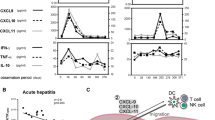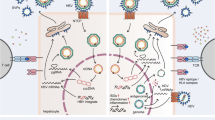Abstract
Chronic viral hepatitis B and C are among the most common and devastating liver diseases worldwide. Immune response plays a crucial role in the course of both diseases. In spite of the importance of the adaptive arm of the immune response, there is a growing role of innate immunity, the earliest confronted with viral attack. Pattern-recognition receptors (PRRs) and, in particular, Toll-like receptors (TLRs) are molecules which are able not only to recognize foreign invaders, but also quickly mount an antiviral defense. Activation of PRRs has been demonstrated in both hepatitis types, i.e. in situ in the liver and on while blood cells. Both viruses, HCV and HBV, are able to subvert the PRR-mediated antiviral response by means of various proteins and enzymes. HCV acts via the non-structural proteins NS2 and NS3/4A, while HBV HBeAg is inversely correlated with TLR activity. Viral counterattack is particularly directed toward dendritic cells, those creating the link with the adaptive immune response. Apart from TLRs, other PRRs such as RIG-1 and MDA-5 are also able to recognize viral infection and participate in the activation of type I interferon synthesis. TLRs manifest gene polymorphism, which was shown to affect several consequences associated with chronic viral hepatitis such as liver cirrhosis and the outcome of liver allotransplantation. There have been numerous attempts to take advantage of the existence and activity of PRRs for the patients’ benefit. Several authors examined the role of TLR synthetic agonists as inducers of TLR activation. In hepatitis C the most promising agonists appear to be TLR3, 7, and 9 for potential antiviral therapy. PRRs may also act as potent adjuvants in HBV vaccines. Their baseline mRNA levels may have predictive value in the course of antiviral therapy.

Similar content being viewed by others
References
Askar E, Bregadze R, Mertens J et al (2009) TLR3 gene polymorphisms and liver disease manifestations in chronic hepatitis C. J Med Virol 81:1204–1211
Atencia R, Bustamante FJ, Valdivieso A et al (2007) Differential expression of viral PAMP receptors mRNA in peripheral blood of patients with chronic hepatitis C infection. BMC Infect Dis 7:136
Baril M, Racine ME, Penin F et al (2009) MAVS dimer is a crucial signaling component of innate immunity and the target of hepatitis C virus NS3/4A protease. J Virol 83:1299–1311
Breiman A, Grandvaux N, Lin R et al (2005) Inhibition of RIG-I-dependent signaling to the interferon pathway during hepatitis C virus expression and restoration of signaling by IKKepsilon. J Virol 79:3969–3978
Broering R, Wu J, Meng Z et al (2008) Toll-like receptor-stimulated non-parenchymal liver cells can regulate hepatitis C virus replication. J Hepatol 48:914–922
Chen Z, Cheng Y, Xu Y et al (2008) Expression profiles and function of Toll-like receptors 2 and 4 in peripheral blood mononuclear cells of chronic hepatitis B patients. Clin Immunol 128:400–408
Crispe IN (2009) The liver as a lymphoid organ. Annu Rev Immunol 27:147–163
Dolganiuc A, Garcia C, Kodys K et al (2006) Distinct Toll-like receptor expression in monocytes and T cells in chronic HCV infection. World J Gastroenterol 12:1198–1204
Eid AJ, Brown RA, Paya CV et al (2007) Association between toll-like receptor polymorphisms and the outcome of liver transplantation for chronic hepatitis C virus. Transplantation 84:511–516
Foy E, Li K, Sumpter R Jr, Loo YM et al (2005) Control of antiviral defenses through hepatitis C virus disruption of retinoic acid-inducible gene-I signaling. Proc Natl Acad Sci USA 102:2986–2991
Gabele E, Muhlbauer M, Dorn C et al (2008) Role of TLR9 in hepatic stellate cells and experimental liver fibrosis. Biochem Biophys Res Commun 376:271–276
Gondois-Rey F, Dental C, Halfon P et al (2009) Hepatitis C virus is a weak inducer of interferon alpha in plasmacytoid dendritic cells in comparison with influenza and human herpesvirus type-1. PLoS One 4:e4319
Guo H, Jiang D, Ma D et al (2009) Activation of pattern recognition receptor-mediated innate immunity inhibits the replication of hepatitis B virus in human hepatocyte-derived cells. J Virol 83:847–858
He Q, Graham CS, Durante Mangoni E et al (2006) Differential expression of Toll-like receptor mRNA in treatment non-responders and sustained virologic responders at baseline in patients with chronic hepatitis C. Liver Int 26:1100–1110
Hoffmann M, Zeisel MB, Jilg N et al (2009) Toll-like receptor 2 senses hepatitis C virus core protein but not infectious viral particles. J Innate Immun 1:446–454
Honda M, Yamashita T, Ueda T et al (2006) Different signaling pathways in the livers of patients with chronic hepatitis B or chronic hepatitis C. Hepatology 44:1122–1138
Isogawa M, Robek MD, Furuichi Y et al (2005) Toll-like receptor signaling inhibits hepatitis B virus replication in vivo. J Virol 79:7269–7272
Kanto T (2008) Virus associated innate immunity in liver. Front Biosci 13:6183–6192
Kaukinen P, Sillanpää M, Kotenko S et al (2006) Hepatitis C virus NS2 and NS3/4A proteins are potent inhibitors of host cell cytokine/chemokine gene expression. Virol J 3:66
Lee J, Wu CC, Lee KJ et al (2006) Activation of anti-hepatitis C virus responses via Toll-like receptor 7. Proc Natl Acad Sci USA 103:1828–1833
Li K, Foy E, Ferreon JC et al (2005) Immune evasion by hepatitis C virus NS3/4A protease-mediated cleavage of the Toll-like receptor 3 adaptor protein TRIF. Proc Natl Acad Sci USA 102:2992–2997
Li Y, Chang M, Abar O et al (2009) Multiple variants in toll-like receptor 4 gene modulate risk of liver fibrosis in Caucasians with chronic hepatitis C infection. J Hepatol 51:750–757
Libri NA, Barker SJ, Rosenberg WM et al (2009) A class C CpG toll-like receptor 9 agonist successfully induces robust interferon-alpha production by plasmacytoid dendritic cells from patients chronically infected with hepatitis C. J Viral Hepat 16:315–324
Lok AS, McMachon BJ (2001) Chronic hepatitis B. Hepatology 34:1225–1241
Machida K, Cheng KT, Sung VM et al (2006) Hepatitis C virus induces toll-like receptor 4 expression, leading to enhanced production of beta interferon and interleukin-6. J Virol 80:866–874
McHutchison JG, Bacon BR, Gordon SC et al (2007) Phase 1B, randomized, double-blind, dose-escalation trial of CPG 10101 in patients with chronic hepatitis C virus. Hepatology 46:1341–1349
Miller RL, Meng TC, Tomai MA (2008) The antiviral activity of Toll-like receptor 7 and 7/8 agonists. Drug News Perspect 21:69–87
Mozer-Lisewska I, Slużewski W, Kaczmarek M et al (2005) Tissue localization of Toll-like receptors in biopsy specimens of liver from children infected with hepatitis C virus. Scand J Immunol 62:407–412
Mozer-Lisewska I, Służewski W, Dworacki G et al (2006) Expression of Toll-like receptors on white blood cells of peripheral blood in children with chronic viral hepatitis C. Przegl Epidemiol 60:657–663 (in Polish)
Paik YH, Schwabe RF, Bataller R et al (2003) Toll-like receptor 4 mediates inflammatory signaling by bacterial lipopolysaccharide in human hepatic stellate cells. Hepatology 37:1043–1055
Pockros PJ, Guyader D, Patton H et al (2007) Oral resiquimod in chronic HCV infection: safety and efficacy in 2 placebo-controlled, double-blind phase IIa studies. J Hepatol 47:174–182
Rantala M, van de Laar MJ (2008) Surveillance and epidemiology of hepatitis B and C in Europe—a review. Euro Surveill 13(21). pii: 18880
Riordan SM, Skinner NA, Kurtovic J et al (2006) Toll-like receptor expression in chronic hepatitis C: correlation with pro-inflammatory cytokine levels and liver injury. Inflamm Res 55:279–285
Saito T, Gale M Jr (2008) RIG-I mediated hepatic innate immune signaling that controls HCV infection. Uirusu 58:105–115 (in Japanese)
Schott E, Witt H, Neumann K et al (2007) A Toll-like receptor 7 single nucleotide polymorphism protects from advanced inflammation and fibrosis in male patients with chronic HCV-infection. J Hepatol 47:203–211
Schroder NW, Schumann RR (2005) Single nucleotide polymorphisms of Toll-like receptors and susceptibility to infectious disease. Lancet Infect Dis 5:156–164
Seki E, Brenner DA (2008) Toll-like receptors and adaptor molecules in liver disease: update. Hepatology 48:322–335
Shehata MA, Abou El-Enein A, El-Sharnouby GA (2006) Significance of toll-like receptors 2 and 4 mRNA expression in chronic hepatitis C virus infection. Egypt J Immunol 13:141–152
Takeda K, Kaisho T, Akira S (2003) Toll-like receptors. Annu Rev Immunol 21:335–376
Tasaka M, Sakamoto N, Itakura Y et al (2007) Hepatitis C virus non-structural proteins responsible for suppression of the RIG-I/Cardif-induced interferon response. J Gen Virol 88:3323–3333
Thomas A, Laxton C, Rodman J et al (2007) Investigating Toll-like receptor agonists for potential to treat hepatitis C virus infection. Antimicrob Agents Chemother 51:2969–2978
Tu Z, Bozorgzadeh A, Pierce RH et al (2008) TLR-dependent cross talk between Kupffer cells and NK cells. J Exp Med 205:233–244
Tu Z, Pierce RH, Kurtis J et al (2010) Hepatitis C virus core protein subverts the anti-viral activities of human Kupffer cells. Gastroenterology 138:305–314
Vincent IE, Lucifora J, Durantel D et al (2009) Inhibitory effect of the combination of CpG-induced cytokines with lamivudine against hepatitis B virus replication in vitro. Antivir Ther 14:131–135
Visvanathan K, Skinner NA, Thompson AJ et al (2007) Regulation of Toll-like receptor-2 expression in chronic hepatitis B by the precore protein. Hepatology 45:102–110
Waggoner SN, Hall CH, Hahn YS (2007) HCV core protein interaction with gC1q receptor inhibits Th1 differentiation of CD4+ T cells via suppression of dendritic cell IL-12 production. J Leukoc Biol 82:1407–1419
Wang B, Trippler M, Pei R et al (2009) Toll-like receptor activated human and murine hepatic stellate cells are potent regulators of hepatitis c virus replication. J Hepatol 51:1037–1045
Wei XQ, Guo YW, Liu JJ et al (2008) The significance of Toll-like receptor 4 (TLR4) expression in patients with chronic hepatitis B. Clin Invest Med 31:E123–E130
Xie Q, Shen HC, Jia NN et al (2009) Patients with chronic hepatitis B infection display deficiency of plasmacytoid dendritic cells with reduced expression of TLR9. Microbes Infect 11:515–523
Xu N, Yao HP, Sun Z et al (2008) Toll-like receptor 7 and 9 expression in peripheral blood mononuclear cells from patients with chronic hepatitis B and related hepatocellular carcinoma. Acta Pharmacol Sin 29:239–244
Xu Y, Hu Y, Shi B et al (2009) HBsAg inhibits TLR9-mediated activation and IFN-alpha production in plasmacytoid dendritic cells. Mol Immunol 46:2640–2646
Yonkers NL, Rodriguez B, Milkovich KA et al (2007) TLR ligand-dependent activation of naive CD4 T cells by plasmacytoid dendritic cells is impaired in hepatitis C virus infection. J Immunol 178:4436–4444
Yuki N, Matsumoto S, Kato M, Yamaguchi T (2010) Hepatic Toll-like receptor 3 expression in chronic hepatitis C genotype 1 correlates with treatment response to peginterferon plus ribavirin. J Viral Hepat 17:130–138
Zhang Z, Zou ZS, Fu JL et al (2008) Severe dendritic cell perturbation is actively involved in the pathogenesis of acute-on-chronic hepatitis B liver failure. J Hepatol 49:396–406
Zhang W, Du X, Zhao G et al (2009) Levamisole is a potential facilitator for the activation of Th1 responses of the subunit HBV vaccination. Vaccine 27:4938–4946
Acknowledgments
This work was supported by the grant no. NN401174733 from the Polish Ministry of Science and Higher Education (to I. Mozer-Lisewska).
Author information
Authors and Affiliations
Corresponding author
About this article
Cite this article
Mozer-Lisewska, I., Sikora, J., Kowala-Piaskowska, A. et al. The Incidence and Significance of Pattern-Recognition Receptors in Chronic Viral Hepatitis Types B and C in Man. Arch. Immunol. Ther. Exp. 58, 295–302 (2010). https://doi.org/10.1007/s00005-010-0087-9
Received:
Accepted:
Published:
Issue Date:
DOI: https://doi.org/10.1007/s00005-010-0087-9




